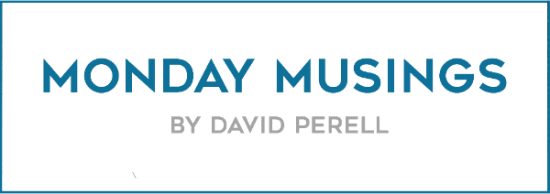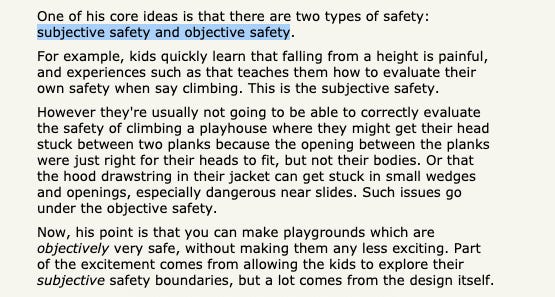Monday Musings (5/20/19)
Improving New York City

Quick update: I’m halfway done with my five-week online course called Write of Passage. To create the course, I compressed five years of learning into five weeks of live instruction.
The internet is the largest legal wealth creation tool in human history. Unfortunately, most people aren’t using it properly. As a result, they’re missing out on the personal and career opportunities that come from writing online.
By the end of the course, all 150 students will have a personal website, an email newsletter, and a body of written work. Spoiler alert: I have some outstanding students. Even better, they’re already leveling up. Three Write of Passage students have already reaped the positive benefits of writing online:
Packy McCormick (VP of Experience at Breather) has built his website, launched his email newsletter, and written an introduction to Ben Thompson’s tech analysis.
Lindsey Honari just did an 8-minute segment on an online radio show. Her answers were inspired by her “Start Here” page, which she created in the 2nd week of the course.
I also liked Patrick Thomas’ email newsletter sign-up page. He’s the Head of Marketing Communications for Google EMEA and builds the narratives for their biggest product launch events. Look at that bio!

The course testimonials have been outstanding. One student wrote:
“The course is exceeding my expectations so far. I’m in a traditional finance career and not 100% sure how it will play out but wake up every day with a dozen exciting thought. Number one positive has been the density. It is obvious you both respect students time and have distilled a MASSIVE amount of info into ultra high quality content for us to consume. Thank you.”
Write of Passage will open up for sale again in the summer. It’s for serious people looking to seriously transform their career. If you’re interested in participating, you can sign up here to receive the latest information.
Improving New York City
We can reduce crime if we change our thinking. Right now, when policymakers want to improve the safety of a dangerous neighborhood, they fall back on the intuitive solution: employ more police officers. In New York, where I live, they are everywhere. With 36,000 officers and 19,000 civilian employees, the New York City Police department is the largest municipal police department in the United States.
A large police force is a terrible investment. The best investments compound in value and police officers offer few accumulating advantages. They are a temporary fix and the opportunity cost of paying them is extraordinary.
Whenever I see a storm of police officers, I think: What are the structural issues that makes all these police officers necessary?
The heuristic isn’t perfect, but it’s helpful. To be sure, some police officers are necessary. But as of now, they absorb too many taxpayer resources. Rather than overspending on police officers, we should pursue structural improvements to dangerous neighborhoods.
Luckily, there are proven ways to increase night-time safety. Dangerous neighborhoods suffer from low-lighting, closed restaurants, and downright ugliness. If we can fix these structural issues, we can reduce crime and increase safety. Moreover, making smart structural improvements will bring accumulating advantages. Sure, the fixed costs are steep but the long-term rewards are worth it. Better yet, the high fixed costs of infrastructure improvements will be softened by their low operating costs.
If New York wants to make its streets safer, it should invest in sustainable, long-term oriented improvements. Potential improvements include (1) public street lighting, (2) 24-hour fast food restaurants, and (3) metal shutters with children painted on them.
I’ll take each in turn.
Public Street Lighting: A quick story: San Francisco is notorious for car break-ins. Growing up, my family lived in a quiet neighborhood in the heart of San Francisco. There were no street lights, so it was dark at night. Moreover, the dense, ground-crawling San Francisco fog exaggerated the darkness and made our neighborhood a target for theft. I have distinct horrors of morning walks towards our pickle-green Toyota Camry station wagon on the way to school, only to see the right window smashed, the radio stolen, and the glove compartment unlocked. To my middle school self, these break-ins were horrifying. During these years, I was also a die-hard San Francisco Giants fan. Every couple of weeks, I attended a game with my father. Usually, we drove to the game. Brilliantly, my father always parked under a public street light. He had experienced numerous San Francisco break-ins, and knew that parking under a bright streetlight would reduce the chance of a shattered window. He was right. In all our years going to Giants games and parking in San Francisco’s unpleasant SOMA district, our car was never broken into. My father was prescient: a recent study in New York randomly added temporary streetlights to public developments. Communities with more temporary lighting benefited from a 36% reduction in nighttime outdoor crimes. Street lighting is a simple way to reduce crime and prevent current and future children from the anguish of car break-ins.
24-Hour Fast Food Restaurants: Coastal elites love to hate on fast food restaurants. Look, I get it. I watched Supersize Me too. Eating McDonald’s every day for a month is asking for obesity and heart disease. With the exception of delicious Egg McMuffin breakfast sandwiches, I’ve avoided McDonald's like a hospital cancer ward. But as a society, we ignore the benefits of fast food at our peril. Fast food restaurants are free policing. In San Francisco, where I grew up, I was once stuck on a sketchy corner of Ocean Avenue at 2AM. Instead of waiting for my ride on the street, I walked into the McDonald's and waited in a bright environment where I felt safe. Here’s my point: fast food restaurants don’t just serve food. They double as a safe, well-lit place to wait for a ride or use the restroom. Rather than hiring police, we can reduce crime and increase safety by providing tax incentives for fast-food restaurants to stay open 24 hours per day. Even though they serve unhealthy food, fast food restaurants are a self-policing mechanism for society. Ultimately, a street where restaurants are open is much safer than a street where restaurants are closed.
Pretty Metal Shutters: Stores in many crime-ridden areas cover their windows at night with ugly metal shutters. While the shutters protect the individual stores, they increase total neighborhood crime. Researchers believe the shutters increase crime because they implicitly communicate that the area is lawless. Stores face a tradeoff: they can either remove their shutters and increase the risk of a break-in or keep their shutters down at the expense of neighborhood crime rates. Turns out, the tradeoff between crime and shutters may be unnecessary. Research shows that “Disney faces” — large-eyed human faces with the proportions of young children have a calming effect. Early studies show that crime can be reduced by painting shop shutters with the faces of babies and toddlers. Moreover, painting the shutters is much less expensive than policing.

These lessons apply far beyond New York City government policy. They apply to many parts of life, from leadership to education to corporate management.
The status quo isn't necessarily optimal. In the case of crime, we spend too much money finding people who’ve committed crimes, incarcerating them, and not enough on stopping crime altogether. In the case of prevention, the standard solution to reducing crime is “hire more police.” Rather than fixing the structural issues, we often put a band-aid on the problem and mistake it for a long-term solution.
We can do better. As a general rule, it’s better to look for underlying fixes that prevent the needs for topical solutions in the first places. The quest to improve safety should begin with bright street lights, 24-hour fast food restaurants, and painted shutters.
Note: If you have thoughts, please share them. I welcome your respectful disagreement.
Fresh Ideas
New Article: Why Maps Lie to You
I turned last week’s comments about maps into a short article. Maps lie to us — for good reason. Contrary to popular belief, they don’t need to be accurate to be useful.
You can read the full article here.
New Podcast #1: North Star Podcast with Jason Zweig
I interviewed Jason Zweig, the legendary Wall Street Journal reporter. He's also the author of the revised edition of Benjamin Graham's The Intelligent Investor, which Warren Buffett has described as "by far the best book about investing ever written."
Conversation topics:
The evening Jason spent with Charlie Munger at his home in Southern California.
Jason's collaboration with Daniel Kahneman, the Nobel Prize winning behavioral economist.
Jason's experience growing up on a small farm in upstate New York
Why Jason's Wall Street Journal columns are intended to save investors from themselves.
Why writing demands fresh language.
As always, I’ve published a full transcript on my website.
You can listen here: Website | Spotify | iTunes
New Podcast #2: I Was Interviewed on the Modern Wisdom Podcast
This time, I was interviewed. Most of the conversation was devoted to the power of writing online and my online course, Write of Passage.
You can listen here: iTunes | YouTube
Coolest Things I Learned This Week
Buddhism and Christianity
I hadn’t considered these symbolic differences between Buddhism and Christianity:
“As we have taken the circle as a symbol of reason and madness, we may very well take the cross as a symbol at once of mystery and health. Buddhism is centripetal, but Christianity is centrifugal: it breaks out. For the circle is perfect and infinite in its nature; but it is fixed for ever in its size; it can never be larger or smaller. But the cross, though it has at its head a collision and a contradiction, can extend its four arms for ever without altering its shape. Because is has a paradox in its center it can grow without changing. The circle returns upon itself and is bound. The cross opens its arms to the four winds; it is a signpost for free travelers.”
Source: Orthodoxy
The Patrick Collision Question
Patrick Collision is the founder and CEO of Stripe. In nearly every product strategy meeting, he asks some variant of these two questions:
Is this the most ambitious plan you could come up with?
What would you propose if you had unlimited resources?
Playground Design: Subjective Safety vs. Objective Safety
From a successful playground designer who wins 90+% of his bids:

Ancestry by Geography

Mean Reversion in Investing
From NYU Professor Aswath Damodaran:
"The world is shifting under us.
There is a point to make about mean reversion: mean reversion works until it doesn’t. And much of what we do in investing now, we learned in the US on data from the second half of the 20th century. And in that time period the US market was a unique market. If you look at the history of markets over time, it was the most mean reverting, stable market of all time. And when you take the most mean-reverting, stable market of all time, all kinds of mean reversion are going to work for you.
So my concern is that maybe we’re taking rules that were developed for the most mean-reverting, stable market of all time and trying to apply them in a new world order where markets might be reverting, but we don’t know to what. And so, I have a concern with any kind of tilted approach where you’re tilting based on past data.
For me, 2008 was the dividing line where I think there was a structural break in the global markets. I am less and less trusting of mean reversion on a daily basis.”
Early Failure, Late Success
A paper about scientists who applied for U.S National Institutes of Health (NIH) grants found that early career setbacks helped scientists in their careers.
Most people believe that early success in science begets future success, but this paper shows that early career setbacks can spark future achievements down the road.
The abstract says:
"By focusing on grant proposals that fell just below and just above the funding threshold, we compare “near-miss” with “near-win” individuals to examine longer-term career outcomes. Our analyses reveal that an early-career near miss has powerful, opposing effects. On one hand, it significantly increases attrition, with one near miss predicting more than a 10% chance of disappearing permanently from the NIH system. Yet, despite an early setback, individuals with near misses systematically outperformed those with near wins in the longer run, as their publications in the next ten years garnered substantially higher impact. We further find that this performance advantage seems to go beyond a screening mechanism, whereby a more selected fraction of near-miss applicants remained than the near winners, suggesting that early-career setback appears to cause a performance improvement among those who persevere. Overall, the findings are consistent with the concept that “what doesn’t kill me makes me stronger.” Whereas science is often viewed as a setting where early success begets future success, our findings unveil an intimate yet previously unknown relationship where early-career setback can become a marker for future achievement, which may have broad implications for identifying, training and nurturing junior scientists whose career will have lasting impact.
Photo of the Week

Every podcast is fun to record. But some feel special. This conversation with Jason Zweig definitely fell into the special category.
There’s a great section towards the end where Jason talks about his childhood desire to become the first author to win a Nobel Prize before the age of 30. He regrets that attitude. But I pushed back. I think some arrogance is helpful, at least in the early days. In that way, Jason reminds me of some Silicon Valley founders who are 100% confident they’ll change the world.
Listen, leave a review, and let me know what you think.
Until next week,
David Perell
